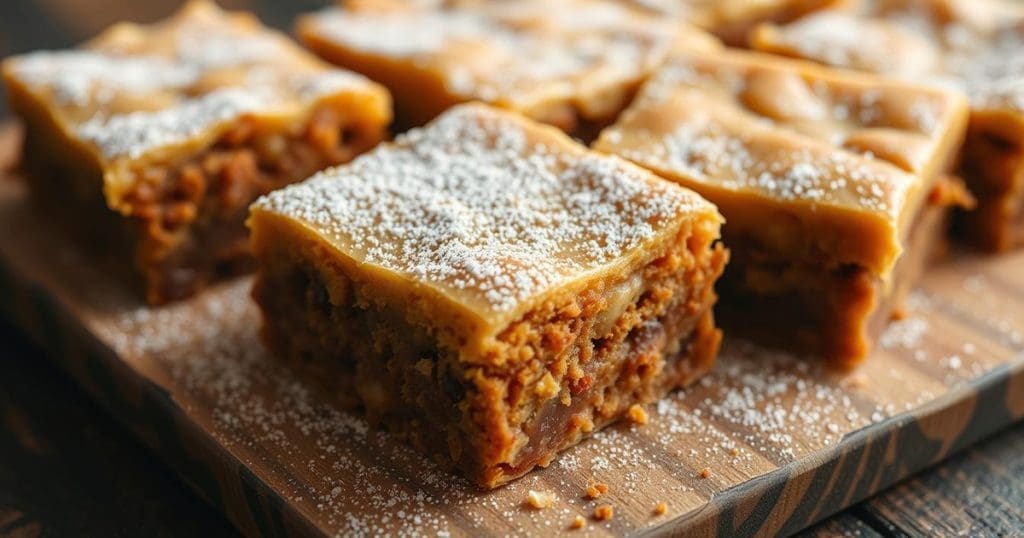Did you know butterscotch was first made in 1800s England by Samuel Parkinson? It was so loved that even Queen Victoria enjoyed it. This golden treat’s legacy lives on in butterscotch brownies, celebrated every May 9. Yet, the person who declared National Butterscotch Brownie Day remains a mystery—leaving us to thank them anonymously for this sweet observance.

These buttery squares, also called “brookies,” mix chewy brownie texture with cookie-like crunch. Their roots go back to 1896, when Fannie Farmer’s recipe used molasses instead of chocolate. Today, they’re reimagined in forms like salted caramel or gluten-free varieties, proving their timeless appeal. Whether served with ice cream or shared at gatherings, butterscotch brownies are more than a snack—they’re a 200-year-old tradition worth celebrating. This guide explores their history, creative recipes, and ways to enjoy this food holiday to the fullest.
What is National Butterscotch Brownie Day?
National Butterscotch Brownie Day is a special day to celebrate a sweet treat. It’s on May 9 every year. This day is all about enjoying butterscotch brownies, also known as blondies, which have been around for over a century.
These brownies have a rich history, even before chocolate brownies were invented in 1905. It’s a time to have fun and try a flavor that’s a bit older than chocolate brownies.
A Brief History
The exact start of butterscotch brownies is a mystery, but they go back to the 1800s. Nestle’s butterscotch chips came out in 1939, making them more popular. Today, these treats are known as blondies, made with butter, sugar, and vanilla.
Celebration Date
May 9 is when we celebrate this food holiday. It has become more popular over the years. Events like the Butterscotch Brownie Challenge bring people together.
Even food trucks like NYC’s The Treats Truck, owned by Kim Ima, join in. It’s a day to share the love for these treats.
Significance of the Day
This day is all about keeping culinary traditions alive. It also helps people connect over their love for desserts. Yelp reviews show how much people love it, calling it “the best” treat.
It reminds us that simple desserts like blondies can bring joy and spark creativity. Whether you make them at home or get them from a bakery, it’s a special day.
How to Celebrate National Butterscotch Brownie Day
Make this day special with these easy ideas. From baking to sharing online, every action makes it a fun dessert day.
Butterscotch’s history began in 18th-century England, later inspiring American blondie recipes that remain favorites today.

Baking at Home
Get creative in the kitchen with recipes like Salted Butterscotch Brownies with Maple Butter Sauce or Butterscotch Brownie Bars. Even newbies can make these gooey treats. Try vegan or gluten-free options for everyone to enjoy.
Sharing with Friends
Organize a butterscotch-themed party where everyone enjoys homemade or store-bought treats. Bring blondies to work or surprise local bakeries with a thank-you note. Your support helps them keep making delicious treats.
Social Media Celebrations
Post pictures of your brownies or brookies (mini bites) on social media. Use #NationalButterscotchBrownieDay to join the fun. Tag brands like Fannie Farmer’s or your favorite bakery. Share your treat with vanilla ice cream and watch your post go viral!
The Origins of Butterscotch Brownies
Every bite of butterscotch brownies tells a story. It starts in 19th-century England and ends in American kitchens. It’s about how butter and brown sugar became a beloved treat.
What is Butterscotch?
Butterscotch was first made in Doncaster, England. Confectioner Samuel Parkinson created it as hard candy. The name comes from “butter” and “scotch,” meaning treacle, a sugar byproduct.
Traditional recipes mix butter, brown sugar, and cream. They simmer until it reaches a soft crack stage. This syrup is different from toffee, making it great for desserts like pies and candies.
By the 1800s, butterscotch was loved by royalty. This made it a key part of culinary history.
Evolution of Brownies
Butterscotch brownies, then called brownies, started in 1896. Fannie Farmer’s recipe used molasses and butter, making fudgy bars known as “blondies.” Chocolate brownies came a decade later, but butterscotch ones stayed popular.
The term “blondie” became common in the 1980s. It helped tell them apart from chocolate brownies. The name “brownie” comes from Palmer Cox’s “Brownies” characters, meaning small but delightful treats.
Today, butterscotch dessert recipes keep this tradition alive. They show that classic flavors can be creative and enduring.
Must-Try Butterscotch Brownie Recipes
These butterscotch dessert recipes offer a mix of classic and creative options. They are perfect for both beginners and experienced bakers. Each recipe combines rich flavors with simplicity.

The Classic Butterscotch Brownies use NESTLÉ® TOLL HOUSE® morsels for a smooth texture. Mix 2 1/2 cups of flour, baking powder, and salt. Then, cream butter, brown sugar, and vanilla, adding morsels later.
Bake until they’re golden and let them cool. For a crunchy top, sprinkle more morsels before baking.
The Butterscotch Swirl Brownies are a feast for the eyes. Mix caramel syrup into half the batter. Layer it with plain batter in a pan.
Use a knife to create swirls before baking. Top with melted morsels or a salted caramel glaze for a fancy look.
For those who prefer plant-based options, try the Vegan Butterscotch Brownies. Replace butter with canola oil and eggs with a flax egg or mashed beans. Use agave or maple syrup for sweetness and carob powder for depth.
The result is fudgy brownies with a nutty taste. Add nuts or dark chocolate chips for extra crunch.
These recipes can be customized—try coconut flakes or espresso powder for different flavors. Serve with vanilla ice cream or tea to make any event special. Whether you prefer the classic or vegan version, these sweet treats showcase butterscotch’s enduring charm.
Suggested Pairings for Butterscotch Brownies
Make any dessert celebration special with the right pairings. Butterscotch brownies are amazing when matched with the right textures and tastes. This creates unforgettable flavor combinations.
Ice Cream Alternatives
Try salted caramel or coffee ice cream instead of vanilla. Custard adds a smooth contrast. Fruit compotes like raspberry or mango add a tangy twist.
Drizzle whipped cream over warm brownies for an extra treat. It turns them into a show-stopping dessert.
Beverages That Complement
Hot chocolate or spiced cider are perfect for cozy gatherings. For adults, red wines like Merlot or Cabernet Franc complement the caramel flavors. Coffee or chai tea balances the richness.
Festive punches add fun to holiday parties. Milk and chocolate chip cookies are great for kids. They ensure everyone enjoys the treats.
Fun Facts About Brownies and Butterscotch
From kitchen experiments to cultural icons, butterscotch brownies and their history hold surprises even seasoned bakers might not know. This food holiday celebrates flavors rooted in tradition and innovation.

“The first known recipe for blondies (which later evolved into brownies) was published by Fannie Farmer, a pioneer of modern American cookery.”
Brownies in American Culture
Blondies—now known as butterscotch brownies—emerged in the late 1800s, before chocolate brownies. Their simplicity made them a Depression-era staple. Modern twists like “brookies” (a mix of brownie and cookie textures) keep them trendy.
A playful rumor claims poet Elizabeth Barrett Browning’s “How do I love thee?” was inspired by a brownie moment. But historians laugh it off as folklore.
The Versatility of Butterscotch
Butterscotch’s origins trace to Yorkshire, where confectioner Samuel Parkinson created it in 1816. His “Royal Doncaster Butterscotch” gained royal approval under Queen Victoria. This nod is seen in products today.
Beyond National Butterscotch Brownie Day, this golden delight stars in January’s National Blond Brownie Day. It proves its appeal all year. Unlike caramel’s creamy milk base, butterscotch’s butter-and-sugar blend creates a distinct tangy sweetness.
Decorating Your Butterscotch Brownies
Turn simple butterscotch brownies into stunning sweet treats with creative touches. Adding caramel drizzle or sprinkled nuts can make your homemade butterscotch dessert recipes stand out.
Frosting Ideas
Cream cheese frosting brings a tangy twist. Mix softened cream cheese with powdered sugar and vanilla, then pipe it on cooled brownies. For a richer taste, melt butter, brown sugar, and cream to make butterscotch frosting.
Drizzle cooled ganache over brownies for a glossy look. This pairs well with butterscotch’s caramel flavor.
Topping Suggestions
Caramel drizzle made from butter, brown sugar, and cream adds a crackly surface. Press toasted nuts or rice krispies into warm batter for texture. Sprinkle flaky sea salt over warm brownies for a sweet balance.
Edible gold leaf adds luxury, while seasonal toppings like pumpkin spice or peppermint flakes fit holidays.
Try maple butter sauce drizzled alongside brownies for a rich touch. Layer chocolate shavings or fresh berries as accents. Even a simple dusting of powdered sugar can highlight your homemade butterscotch brownies without overpowering their taste.
Popular Brands and Products for Brownies
When time is short, top brands offer quality butterscotch brownies for any celebration. You can buy them ready-to-eat or make them at home. Trusted names make it easy to enjoy this sweet treat.
Store-Bought Options
Grocery stores have brands like Godiva and Betty Crocker’s ready-to-eat butterscotch blondies. Artisan bakeries offer premium versions with butterscotch filling. Look for products with real morsels or caramel notes for authentic flavor.
Homemade Mixes
NESTLÉ TOLL HOUSE Butterscotch Morsels (1 2/3 cups per batch) add signature flavor to boxed mixes. Betty Crocker’s brownie kits let you add nuts or espresso. For those who like to bake from scratch, Ghirardelli cocoa or Guittard chocolate chips work well with butterscotch swirls.
Hosting a Butterscotch Brownie Party
Make National Butterscotch Brownie Day special with a themed party. It’s great for small groups or big food holiday events. This party is all about sharing love for sweet treats with friends.
Theme Ideas
Go for a vintage theme to honor butterscotch’s history. Or, have a “best brownie” contest. Decorate with golden and caramel colors to match the flavor.
Serve the classic recipe, making 16 squares. Pair it with hot cider or cocoa, as bakers suggest.
Games and Activities
Do blind taste tests to guess butterscotch ingredients. Set up a topping station with nuts or chocolate shavings. Share trivia about brownie history, like their 19th-century start.
Have guests share their favorite recipes in a “swap” jar. This food holiday is perfect for making memories and laughter around the kitchen table.
Healthier Alternatives for Brownies
Enjoying butterscotch dessert recipes doesn’t mean you have to give up health. Today’s butterscotch brownies can meet dietary needs and taste great. You can find vegan, gluten-free, or low-sugar options that everyone can enjoy.

Ingredient Substitutions
Swap butter with coconut oil or applesauce for a vegan choice. Flaxseed mixed with water can replace eggs, adding fiber. For gluten-free, use almond or oat flour instead of wheat.
Pureed legumes like white or black beans can add protein. Use a 1:1 bean-to-butter ratio, but mix with oil for better texture.
Low-Sugar Options
Reduce sugar by using ripe bananas, dates, or coconut sugar. Try reduced-sugar butterscotch chips or dark chocolate chips for less sweetness. Adding nuts like walnuts or pecans brings healthy fats and protein.
Remember, portion control is key. Enjoy small bites of rich butterscotch brownies to satisfy your cravings without overdoing it.
Conclusion: Enjoying National Butterscotch Brownie Day
National Butterscotch Brownie Day is more than just a food holiday. It’s a time to enjoy tradition and creativity. It invites everyone to learn about these treats’ history and make new memories with family and friends.
Reflecting on Tradition
The history of butterscotch goes back to 19th-century Scotland. There, caramelized sugar mixed with butter and cream became a beloved flavor. Brownies, first made at Chicago’s 1893 World’s Fair, have grown from a simple recipe to today’s rich versions.
These treats connect us to the past and to cultural moments. For example, the first chocolate-infused recipe was in 1897. Thomas Joseph, a James Beard Award-winning chef, explores their history in his “Kitchen Conundrums” series.
Making New Memories
Make National Butterscotch Brownie Day special by baking together or sharing recipes. Whether you stick to classic methods or try new twists, each bite celebrates tradition and creates new ones. February 15 also marks National “I Want Butterscotch” Day, adding to the year-round joy.
Let this day inspire both looking back and moving forward. From home kitchens to community gatherings, these brownies bring us together. So, grab a fork and enjoy the moment. Your next batch could become a family favorite for years.


![Black Bean Chocolate Cake [recipe]](https://b3860431.smushcdn.com/3860431/wp-content/uploads/2024/04/Black-Bean-Cake-FB-1024x538.jpg?lossy=2&strip=1&webp=1)

Facebook Comments